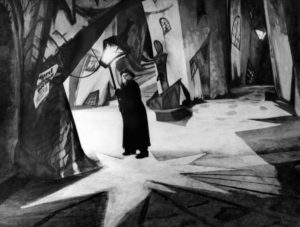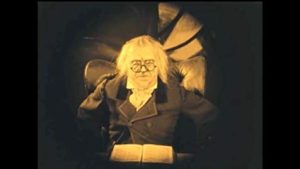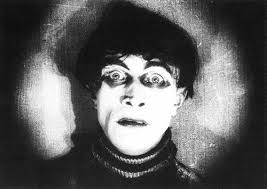Throughout “The Cabinet of Dr. Caligari” (Robert Wiene, 1920) Many different and aspects of this film are regarded as innovative – whether its cinematography, editing or mise-en-scene.
Firstly, it is important to understand that The Cabinet Of Dr Caligari was not produced by a mainstream company, therefore it had limited resources. And because of this, not a lot of money could be spent on artificial lighting so paint was used to indicate lighting and shadows. This is one of the most innovative techniques in my opinion and was a great contribution to the overall verisimilitude of the film. Although the film did not have colour, verisimilitude could still be created effectively due to these innovative techniques.

Additionally the film’s set was extremely innovative. Slanted walls and windows and abstract designs all lead the to the idea of craziness and mental instability / deterioration. It puts us inside the mind of the narrator and pulls us along the journey that follows the deterioration of his mental health. It immerses the audience in another world without the use of CGI or other computer techniques.

Another innovative technique used is the iris wipe. This is done by closing the camera lens whilst still recording so it looks like it is zeroing in on the middle of the screen. This is a very artistic and expressive transition and so is not utilized often in modern film – sometimes it is used to draw attention to specific parts of the scene but during this film it is mostly used to create an interruption in the fluidity of the movie. It refers to the brokenness of the narrator’s and characters’ mind. Additionally the use of a slow transition such as an iris transition causes the audience to feel anticipation for what is to come next.

Finally Cesare’s make-up is considered to be innovative as it reflects the tone of the movie and of the scene. It is very bold and reveals his inner turmoil and conflicting emotions. He also has a very dark costume which further references to his personality and thoughts. Additionally it establishes him as the main villain to us.

Not only that but one must consider the effect that the culture had on German expressionism as a whole. The Weimar Republic was a democratic system that was introduced post world war 1. It was during the time of the Weimar Republic that German expressionism became very popular. This is because Germany had banned imports from other countries and this included films, therefore it was up to German artists and film-makers to create their own works of art. The Weimar Republic was affecting film in a very strong way. Most notably shown in “The Cabinet Of Dr Caligari” through the Mise-En-Scene and set design. Around this time, Germany was in a state of depression and darkness, Wiene was able to directly represent this in the film through the set design, the grass was made to look like knife blades coming out the ground, doors and windows aren’t square. Streets aren’t symmetrical and seem to wind in endlessly unpredictable ways. Everything about it seemed dark and disorderly – a direct representation of Germany at the time.
Finally, thought must be put into examining what this film influenced. “The Cabinet Of Dr Caligari” was incredibly influential and is seen as one of, if not THE, first horror movies. This style of film-making paved the way for the American genre of Noir. The use of shadows and lighting can be clearly linked back to those dark depressing German expressionist films. Additionally German Expressionism has inspired the work of Directors like Tim Burton and Ridley Scott. Shown specifically through films like “Edward Scissorhands” (Tim Burton, 1990) and “Alice In Wonderland”(Tim Burton, 2010) Aswell as “Bladerunner” (Ridley Scott, 1982).
